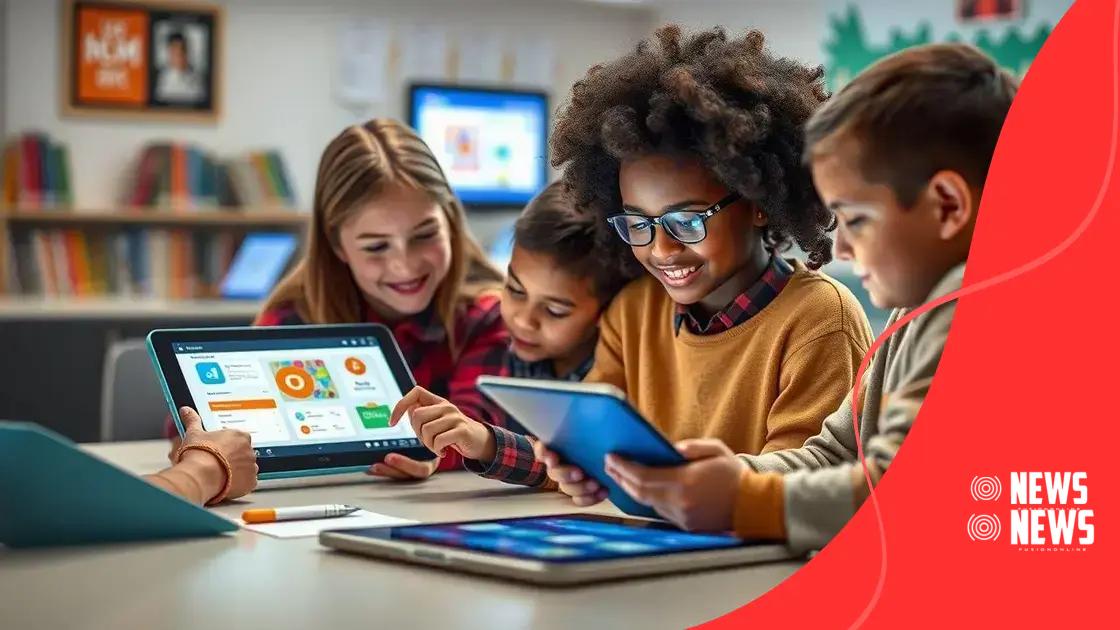Bridging the gap in digital learning opportunities
Bridging the gap in digital learning opportunities involves leveraging technologies like AI and VR, implementing inclusive strategies, and fostering collaboration to ensure equitable access to quality education for all students.
Bridging the gap in digital learning opportunities is more crucial than ever. Have you noticed how technology influences education? Join me as we explore various ways to make learning more accessible for everyone.
Understanding digital learning gaps
Understanding digital learning gaps is essential for creating effective educational strategies. These gaps can hinder students’ abilities to access quality education and technology.
Identifying these gaps involves recognizing the barriers that prevent learners from using digital resources. Many factors contribute to this issue, including socioeconomic status, geographical location, and varying levels of technological proficiency.
Key Barriers to Access
The challenges faced by learners can be vast. Here are some key barriers:
- Technology inequality: Not all students have equal access to devices or internet.
- Skill gaps: Some learners may lack digital skills, limiting their engagement.
- Support systems: A lack of guidance from educators can leave students feeling lost.
Another major aspect to consider is the quality of resources. Educational materials need to be engaging and user-friendly. When resources are outdated or difficult to navigate, students can easily lose interest. Schools and organizations are encouraged to invest in high-quality digital content to keep learners engaged.
Furthermore, the teacher’s role is pivotal in bridging these gaps. Educators need to be equipped with the necessary training to support digital learning initiatives. By doing so, they can foster a positive learning environment that encourages exploration and curiosity.
Strategic Solutions
While understanding the gaps is crucial, it’s equally important to implement solutions. Schools can leverage community resources to provide technology access and training. Collaborations with local governments or nonprofits may bring valuable support to disadvantaged students.
Additionally, inclusive practices should be applied in all digital learning efforts. Creating learning opportunities that cater to diverse needs can help all students thrive. It’s also beneficial to assess learning outcomes regularly to adapt strategies as necessary.
Key challenges in digital education
Key challenges in digital education affect both teachers and students. These challenges can limit the effectiveness of online learning environments and create disparities in education quality.
One significant issue is the lack of access to technology. Many students do not have the necessary devices or reliable internet to participate fully in online classes. This inequality can lead to frustration and disengagement, impacting their academic performance.
Technological Barriers
Moreover, understanding how to use technology is crucial. Some students and teachers struggle with navigating digital platforms. A lack of training can lead to confusion and reduced confidence in using these tools.
- Device availability: Not every student has access to a computer or tablet.
- Internet connectivity: Slow or unreliable internet can hinder learning.
- Digital literacy: Without proper training, both students and teachers may feel lost.
Another major challenge is maintaining student engagement in a virtual environment. With distractions at home, it can be hard to stay focused during online lessons. Teachers must find ways to make their classes interactive and engaging to keep students interested and motivated.
In addition, assessment methods need to adapt to digital learning. Traditional testing approaches may not work well online. Educators may need to explore alternative methods, such as project-based assessments, to accurately evaluate student learning and progress.
Equity in Learning
Equity remains a crucial concern in digital education. It’s vital to address the needs of all students, especially those from disadvantaged backgrounds. Implementing strategies that ensure equal access to resources can help bridge the gap.
Collaboration among educators, parents, and community organizations can provide the support needed for students to overcome these challenges. By working together, they can create an environment conducive to learning and growth, fostering a sense of belonging.
Innovative tools bridging learning divides

Innovative tools play a vital role in bridging learning divides in digital education. These tools help ensure that all students have access to quality learning experiences, regardless of their backgrounds.
One significant advancement is adaptive learning technology. This type of tool tailors educational content to meet the individual needs of each student. By analyzing their learning patterns, adaptive systems provide personalized resources that enhance understanding and retention.
Benefits of Adaptive Learning
Through adaptive learning, students receive support that is just right for them. Here are some benefits:
- Personalized pace: Learners can progress at their own speed, reducing the pressure.
- Focused resources: Content is tailored to address specific gaps in knowledge.
- Increased engagement: Custom learning paths keep students motivated and interested.
Another important tool is collaborative platforms. These platforms allow students to work together, share resources, and communicate effectively. Tools like online forums, chat rooms, and video conferencing make learning more interactive.
Collaboration fosters a sense of community among learners, which can be especially beneficial in online environments. When students engage with their peers, they are more likely to stay committed and participate actively.
Examples of Collaborative Tools
Several platforms help facilitate collaboration. Some of the commonly used tools include:
- Google Classroom: Organizes assignments and communication.
- Moodle: An open-source platform that supports various learning activities.
- Edmodo: A social learning platform that connects students and teachers.
Additionally, gamification in education is gaining traction. By incorporating game elements into learning, educators can make lessons more enjoyable. Gamification can include quizzes, badges, or challenges that motivate students and enhance participation.
As technology continues to evolve, the integration of these innovative tools is essential. They address existing learning divides and contribute to a more inclusive and equitable educational landscape, allowing every student to thrive.
Strategies for inclusive digital learning
Strategies for inclusive digital learning are essential to ensure all students can benefit from education technology. These approaches help create an environment where everyone, regardless of their background or abilities, has access to quality educational resources.
One effective strategy is to implement universal design for learning (UDL). This framework allows educators to create flexible learning environments that accommodate individual learning differences. By using varied teaching methods and materials, teachers can support diverse learners in meaningful ways.
Key Principles of UDL
Applying UDL involves three main principles:
- Multiple means of engagement: Capture students’ attention through various activities and interests.
- Multiple means of representation: Present information in different forms to cater to diverse learning styles.
- Multiple means of action and expression: Allow students to demonstrate their learning through various methods.
Another essential strategy is the use of assistive technology. These tools can help students with disabilities access digital learning materials more effectively. Common examples include text-to-speech software, screen readers, and speech recognition programs.
Assistive technology can significantly enhance the learning experience for students with different needs. By integrating these tools into digital learning platforms, educators can provide tailored support that promotes independence and confidence.
Encouraging Collaboration
Collaboration among students is another important aspect of inclusive learning. Group activities and peer support systems can foster a sense of community and belonging. When students work together, they can share insights and appreciate different perspectives, enriching the learning experience.
Educators should consider diverse groupings, ensuring that all students have opportunities to contribute. This can help break down barriers and strengthen connections among students from different backgrounds.
Finally, ongoing professional development is crucial for teachers. Training workshops can prepare educators to implement inclusive strategies effectively. Understanding the diverse needs of their students allows teachers to adapt their approaches and create a more welcoming learning environment.
Future trends in digital education
Future trends in digital education are evolving rapidly, influenced by technology and changing student needs. Understanding these trends can help educators prepare for the next generation of learners.
One prominent trend is the growing use of artificial intelligence (AI). AI can help personalize learning experiences for students. By analyzing data, AI can offer tailored recommendations and resources that match individual learning styles and paces.
Applications of AI in Education
AI is already making an impact in various ways:
- Intelligent tutoring systems: These provide real-time feedback and guidance to learners.
- Automated grading: AI can help educators save time by quickly assessing student work.
- Data analytics: Insights from student performance can inform teaching strategies.
Another trend is the rise of virtual and augmented reality (VR/AR). These technologies create immersive learning experiences that engage students like never before. With VR, learners can explore historical sites or scientific phenomena up close, while AR can overlay digital information onto the real world.
Benefits of VR/AR in Learning
The use of VR and AR has several advantages:
- Enhanced engagement: Interactive experiences keep students motivated.
- Practical learning: Real-world simulations allow for hands-on practice in a safe setting.
- Diverse perspectives: Students can experience different cultures and environments without leaving the classroom.
Additionally, the trend towards blended learning continues to gain momentum. This approach combines traditional face-to-face teaching with online learning. Blended learning allows for flexibility, enabling students to learn at their own pace while still having access to direct support from their teachers.
In the future, incorporating mobile learning will also be crucial. With the widespread use of smartphones and tablets, educational content must be accessible on these devices. Mobile learning can provide resources anytime and anywhere, meeting the demands of the modern student.
FAQ – Frequently Asked Questions about Digital Education Trends
What role does artificial intelligence play in digital education?
Artificial intelligence personalizes learning experiences, tailoring content to meet individual student needs and enhancing engagement.
How can virtual reality enhance learning?
Virtual reality creates immersive experiences, allowing students to explore environments and concepts in a hands-on way, which increases motivation.
What is blended learning?
Blended learning combines traditional in-person teaching with online methods, offering flexibility and diverse learning opportunities for students.
Why is collaboration important in digital education?
Collaboration fosters a sense of community, allowing students to learn from each other and share various perspectives, enhancing the overall learning experience.





